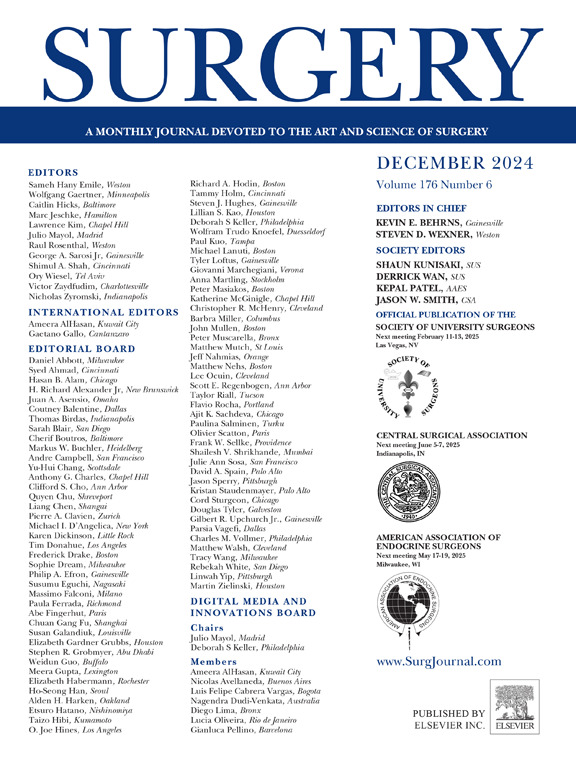Clinical and patient-reported outcomes following subtotal cholecystectomy: 10-year single-institution experience
IF 3.2
2区 医学
Q1 SURGERY
引用次数: 0
Abstract
Objective
Subtotal cholecystectomy provides a safe, bail-out alternative for difficult gallbladders. However, long-term outcomes comparing fenestrating and reconstituting subtotal cholecystectomy subtypes remain underexplored.
Methods
This retrospective cohort included patients who underwent subtotal cholecystectomy between 2010 and 2020 within a single hospital system. Subtotal cholecystectomy was identified by parsing operative notes for keywords. Demographic and clinical variables were collected by manual review. Patient-reported outcomes were collected via phone using an abbreviated Gastrointestinal Quality-of-Life Index.
Results
We identified 218 subtotal cholecystectomies, with 113 (51.8%) fenestrating subtotal cholecystectomy and 105 (48.2%) reconstituting subtotal cholecystectomy and a median follow-up of 63 months (interquartile range 27–106). Rates of bile duct injury (0.9% vs 1.0%; P > .99), bile leak (10.6% vs 9.5%; P > .99), and 30-day readmission (7.6% vs 8.0%; P > .99) did not differ between fenestrating and reconstituting subtotal cholecystectomy. For fenestrating subtotal cholecystectomy, the postoperative bile leak rate decreased fourfold when cystic duct closure was achieved (6.0% vs 24.1%; P = .012). Subtotal cholecystectomies completed laparoscopically had fewer postoperative bile leaks (2.9% vs 16.8%; P = .001), fewer wound complications (4.8% vs 13.3%; P = .035), and decreased length of stay (7.00 ± 9.07 vs 10.15 ± 13.50 days; P < .001) compared with open operations. The survey response rate was 38.9% (n = 51/131); 47 patients (92.2%) did not report recurrent biliary pain or postprandial nausea or vomiting, but 19 patients (37.2%) reported dietary restriction. Long-term completion cholecystectomy rate was 0.9%.
Conclusion
Given no notable difference in postoperative or quality of life outcomes between subtotal cholecystectomy subtypes, consideration of technique depends on intraoperative conditions. Cystic duct closure during fenestrating subtotal cholecystectomy and laparoscopic completion of subtotal cholecystectomy are associated with improved postoperative outcomes.
胆囊次全切除术后的临床和患者报告结果:10 年单一机构经验。
目的:胆囊次全切除术为疑难胆囊提供了一种安全的保胆选择。然而,对胆囊切除术亚型的长期疗效进行比较的研究仍然不足:该回顾性队列包括 2010 年至 2020 年期间在一家医院系统内接受胆囊次全切除术的患者。通过解析手术记录中的关键字来确定胆囊次全切除术。通过人工审核收集人口统计学和临床变量。通过电话使用缩写的胃肠道生活质量指数收集患者报告的结果:我们确定了 218 例胆囊次全切除术,其中 113 例(51.8%)为胆囊切除术,105 例(48.2%)为重建胆囊次全切除术,中位随访时间为 63 个月(四分位间范围为 27-106 个月)。胆管损伤率(0.9% vs 1.0%;P > .99)、胆漏率(10.6% vs 9.5%;P > .99)和 30 天再入院率(7.6% vs 8.0%;P > .99)在开窗次全胆囊切除术和再次开窗次全胆囊切除术之间没有差异。对于胆囊次全切除术,如果实现了胆囊管闭合,术后胆漏率降低了四倍(6.0% vs 24.1%;P = .012)。与开腹手术相比,腹腔镜胆囊次全切除术的术后胆漏更少(2.9% vs 16.8%;P = .001),伤口并发症更少(4.8% vs 13.3%;P = .035),住院时间更短(7.00 ± 9.07 vs 10.15 ± 13.50 天;P < .001)。调查回复率为 38.9%(n = 51/131);47 名患者(92.2%)未报告复发性胆道疼痛或餐后恶心或呕吐,但有 19 名患者(37.2%)报告了饮食限制。长期胆囊切除术完成率为 0.9%:结论:鉴于胆囊次全切除术亚型之间在术后效果或生活质量方面没有明显差异,技术的选择取决于术中情况。胆囊次全切除术和腹腔镜下完成胆囊次全切除术时关闭胆囊管与改善术后效果有关。
本文章由计算机程序翻译,如有差异,请以英文原文为准。
求助全文
约1分钟内获得全文
求助全文
来源期刊

Surgery
医学-外科
CiteScore
5.40
自引率
5.30%
发文量
687
审稿时长
64 days
期刊介绍:
For 66 years, Surgery has published practical, authoritative information about procedures, clinical advances, and major trends shaping general surgery. Each issue features original scientific contributions and clinical reports. Peer-reviewed articles cover topics in oncology, trauma, gastrointestinal, vascular, and transplantation surgery. The journal also publishes papers from the meetings of its sponsoring societies, the Society of University Surgeons, the Central Surgical Association, and the American Association of Endocrine Surgeons.
 求助内容:
求助内容: 应助结果提醒方式:
应助结果提醒方式:


